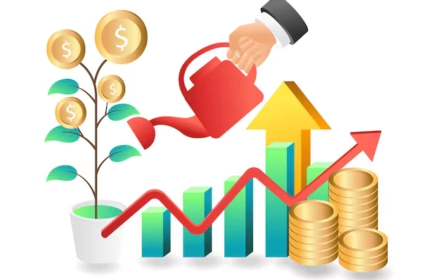Evaluating the profitability of an investment portfolio allows you to see the results, not just expectations. Numbers determine efficiency, point out mistakes, and indicate where the set of assets is performing poorly. Without accurate calculations, it’s impossible to adapt or forecast a strategy.
What Does Evaluating the Profitability of an Investment Portfolio Show
Evaluating investment results reflects the actual capital growth over a selected period, taking into account profits, losses, and all invested funds. The method captures the real returns from instruments, including stocks, bonds, futures, ETFs, and other assets.

The indicator links three key factors:
- market value dynamics of assets;
- holding period;
- receipts from coupons, dividends, and other payments.
An asset pool yielding +14% annually with average risk and inflation below 5% operates efficiently. However, without analyzing the results for each quarter, evaluating the profitability of an investment portfolio loses its meaning — money doesn’t like blind management.
Formulas Are Important, But Not All-Encompassing
Precise calculation requires specific data. The basic formula looks simple: Profit (%) = [(End-of-period value – Beginning value + Income received) / Beginning value] × 100.
For a diversified portfolio, the correct result comes from weighted profit, considering the proportional weight of each asset. Without it, the numbers distort the picture.
The asset pool includes:
- 50% of stocks yielding 10% profit;
- 30% of bonds providing 6% income;
- 20% of futures resulting in -4%.
Only a weighted calculation reflects reality: 0.5×10 + 0.3×6 + 0.2×(–4) = 6.4%. And only such a calculation of the profitability of an investment portfolio will provide an objective benchmark.
How to Calculate Investment Returns
Linking the calculation to a specific time frame is crucial. The same portfolio can show +18% for a quarter and -3% for half a year if the market corrects. The period affects the perception of efficiency.
For assessing an annual term, internal rate of return (IRR) or modified IRR are often used, especially with irregular investments. These formulas are more complex but reflect the dynamics of fund movement. Without IRR, it’s impossible to correctly calculate the result when funds are irregularly invested and payments vary.
Yield and Profit: Understanding the Difference
Investment profit is an absolute value. Yield is relative. The first depends on the investment amount, the second on the effectiveness of placement. An asset pool with a 7% yield may bring in more money than one with 12% if the investment amount is significantly higher.
Real profit from investments is higher in the first case, despite the lower percentage. Here, the analysis of investment portfolio efficiency should consider the goal: maximizing profit or investment efficiency.
Key Steps in Calculation
Precise calculation starts with a clear action plan. Each step affects the outcome — even the slightest deviation distorts the true picture of investment benefits.
Calculating profit percentage involves the following algorithm:
- Choose the calculation period. Start and end dates are fixed. The more accurate the data, the more correct the result.
- Evaluate the initial asset value. All assets are recorded at the beginning date based on market price.
- Gather income data. Include dividends, coupons, option premiums, and transaction incomes.
- Calculate the end-of-period asset value. Market evaluation of all positions, including unrealized profit or loss.
- Compute the yield. Apply a formula or automated calculation through services (e.g., Quik, TradingView, Excel with XIRR).
- Compare with benchmarks and adjust the strategy. Moscow Exchange indices, S&P 500, Central Bank rate — the basis for efficiency analysis.
Only a comprehensive analysis of financial results will provide a precise understanding of how the set of assets is performing.
Evaluating the Profitability of an Investment Portfolio: Factors Affecting the Final Result
Evaluating the profitability of an investment portfolio depends not only on numbers. The key role is played by investment instruments, their combination, volatility, and holding time. Large-cap stocks provide stability but lag in growth compared to venture assets. Bonds mitigate fluctuations but limit investment benefits. Futures accelerate results but involve risks.
A portfolio consisting of 60% stocks, 30% bonds, and 10% derivatives demonstrates moderate profitability with limited drawdown. Meanwhile, the S&P 500 growth in 2023 was 24.2% — above average. However, high-tech company stocks yielded up to 70% profit, while oil futures resulted in a 12% loss.
Each structure requires adjustments. For high-risk levels and long horizons, it’s more beneficial to hold assets with variable yields. For short-term goals, it’s rational to choose instruments with fixed coupons or high liquidity.
Why Calculate the Profitability of an Investment Portfolio
You can’t manage what you don’t measure. Without understanding the current profitability of a securities portfolio, it’s impossible to make informed decisions: buy more assets, move to cash, hedge positions, or change strategy.
For example, during ruble instability, analyzing the profitability of portfolio investments in currency shows real results, not illusory growth against inflation. In 2022, the Moscow Exchange index decreased by 43%, but when recalculated in dollars, the decline was nearly 60%. This example proves that calculations are necessary in both absolute and relative terms.
Tools for Evaluating the Profitability of an Investment Portfolio
Manual calculation is suitable for simple structures. However, for complex portfolios with numerous positions and different holding periods, specialized platforms are required.
Popular solutions include:
- Excel with XIRR function — convenient for accounting for periodic contributions and withdrawals.
- Broker’s personal account (Tinkoff, VTB, BCS) — displays asset dynamics online.
- Platforms like Black Terminal, Fin-Plan — provide analysis, comparison with indices, and automatic indicator calculation.
Each tool provides information with varying levels of detail. It’s important to cross-check results, eliminate errors, and not rely solely on graphs.

Errors Distorting Results
Mistakenly accounting for losses, double-counting dividends, ignoring fees and taxes are common causes of distortions. Also, evaluating returns without considering inflation is unacceptable: 12% annually with official inflation at 9% yields a real profit of only 3%. Only calculating the profitability of portfolio investments considering these factors reflects reality.
Conclusion
Evaluating the profitability of an investment portfolio allows you to see the efficiency of investments and adjust actions promptly. In a dynamic market with constant changes in securities, those who calculate accurately win, rather than just taking risks.
 en
en  de
de  ar
ar  es
es  nl
nl  hi
hi  fr
fr  it
it  pt
pt  el
el 













